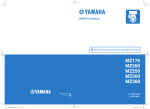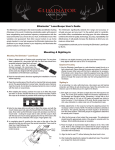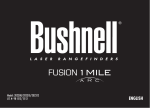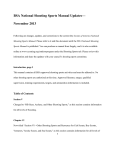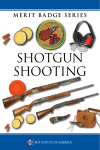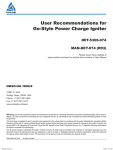Download Bushnell CF 500 Reticle Instruction manual
Transcript
Riflescope Instruction Manual 10-13 Congratulations on your choice of a Bushnell® Banner® riflescope. It is a precision instrument constructed of the finest materials and assembled by highly skilled craftsmen for a lifetime of trouble-free use under the most demanding conditions. This booklet will help you achieve optimum performance by explaining how to use its various features and how to care for it. Read the instructions carefully before mounting and using your scope. The following photographs are guides to the nomenclature and location of the riflescope parts mentioned throughout this text. Power Change Ring Fast Focus Ring Elevation Adjustment Shoulder Eyepiece Windage Adjustment 2 Adjustable Objective (Parallax Compensation) (selected models only) Objective Lens EYEPIECE FOCUSING The eyepiece is designed to provide a precise fast focus. The eyepiece will focus faster than your eye can compensate for any inaccuracy in your adjustment. Look at a distant object for several seconds without using your scope. Then, shift your vision quickly, looking through the scope at a plain background. Turn the fast-focus eyepiece clockwise or counter clockwise to adjust to your eyes. The reticle pattern should be sharp and clear before your eye can refocus. After you have made your adjustment, with a quick glance re-check the image. WARNING: NEVER LOOK AT THE SUN THROUGH THE RIFLESCOPE (OR ANY OTHER OPTICAL INSTRUMENT). IT MAY PERMANENTLY DAMAGE YOUR EYES. CENTERING THE RETICLE The reticle was carefully set at the optical center of your riflescope at our factory. This setting provides you with the ideal adjustment range from the center position. The riflescope’s adjustments are used to zero-in the riflescope. It is wise to check the center of the optical axis before mounting. Do this by placing the scope in a solid V-block (cardboard box with two slots). While looking through the scope in a normal viewing position, carefully rotate the scope. If the target moves in a circle larger than 1” from center (at 25 yards) in relation to intersection of crosshairs, reset windage and elevation adjustments. Remove adjustment caps. Set each adjustment to midpoint and recheck for centering. If target still rotates, use adjustments to correct. MOUNTING To achieve the best accuracy from your rifle, your Bushnell scope must be mounted properly. 3 (We strongly recommend that those unfamiliar with proper procedures have the scope mounted by a qualified gunsmith). Should you decide to mount it yourself: 1. Use a high-quality mount with bases designed to fit your particular rifle. The scope should be mounted as low as possible without touching either the barrel or the receiver. 2. Carefully follow the instructions packed with the scope mounts you have selected. 3. Before tightening the mount rings, look through the scope in your normal shooting position. Adjust the scope (either forward or backward) until you find the furthest point forward (to ensure maximum eye relief ) that allows you to see a full field of view. 4. Rotate the scope in the rings until the reticle pattern is perpendicular to the bore and the elevation adjustment is on top. 5. Tighten the mounting screws. WARNING: IF THE SCOPE IS NOT MOUNTED FAR ENOUGH FORWARD, ITS REARWARD MOTION MAY INJURE THE SHOOTER WHEN THE RIFLE RECOILS. BORE SIGHTING Bore sighting is a preliminary procedure to achieve proper alignment of the scope with the rifle’s bore. It is best done using a Bushnell® Bore Sighter. If a bore sighter is not available, it can be done as follows: Remove the bolt and sight through the gun barrel at a 100 yard target. Then sight through the scope and bring the cross hairs to the same point on the target. Certain mounts have integral windage adjustments and, when bore sighting, these should be used instead of the scope’s internal adjustments. If major elevation adjustments are needed, they should be accomplished by shimming the mount base. 4 ZEROING Final sighting-in of your rifle should be done with live ammunition, based on your expected shooting distance. If most of your shots will be at short range, zero-in at 100 yards. But, for longrange shooting at big game, most experienced shooters zero-in about three inches high at 100 yards. Three-shot groups are useful for averaging the point of impact. ELEVATION AND WINDAGE ADJUSTMENT Bushnell Banner scopes feature finger-adjustable audible-click elevation and windage adjustments. 1. Remove the covers from the Elevation and Windage Adjustments. 2. Grasp the Adjustment Bar and turn it in the appropriate “UP” (and/or “R”) direction indicated by the arrows. Each “click” or increment on the Adjustment Scale Ring will change bullet impact by 1/4” Minute of Angle. 1/4” MOA corresponds to 1/4 inch at 100 yards, 1/2 inch at 200 yards, 3/4 inch at 300 yards and so on (1/12” at 50 feet for air rifles). ELEVATION ADJUSTMENT DIAL WINDAGE ADJUSTMENT DIAL 5 RESETTING THE ADJUSTMENT SCALE RING (this feature is not available on all models) This step is not necessary, but, for future reference, you may want to realign the zero marks on the Adjustment Scale Rings with the index dots. 1. Using a jeweler’s screwdriver, loosen the Phillips screw on the Adjustment Scale about 1/2 turn. Take care not to disturb your zero by “losing” a click or two when loosening the screws. 2. Rotate the Adjustment Scale Ring (which should now turn freely) to align the “O” with the Index Dot. 3. Retighten the screw in the Adjustment Scale and reinstall the Elevation and Windage Adjustment Knobs. VARIABLE POWER ADJUSTMENTS To change magnification, simply rotate the Power Change Ring to align the desired number on the power scale with index dot. When still-hunting or stalking game, a variable scope should be set to the lowest power. You then have the widest field of view for quick shots at close range. Higher powers should be reserved for precise long-range shots. WARNING: A SCOPE SHOULD NEVER BE USED AS A SUBSTITUTE FOR EITHER A BINOCULAR OR SPOTTING SCOPE. IT MAY RESULT IN YOU INADVERTENTLY POINTING THE GUN AT ANOTHER PERSON. ADJUSTABLE OBJECTIVE LENS This feature (if present on your scope) permits precise focusing, while simultaneously readjusting the parallax-free distance, for any range from 50 yards to infinity. To change range focus, turn 6 the Objective Adjustment Ring and align the number with the distance index dot. An alternative method is to look through the scope and turn the Objective Adjustment Ring until the target, at whatever range, is sharply focused. MAINTENANCE Your Bushnell riflescope, though amazingly tough, is a precision instrument that deserves reasonable cautious care. 1. When cleaning the lenses, first blow away any dirt and dust, or use a soft lens brush. Fingerprints and lubricants can be wiped off with lens tissue, or a soft clean cotton cloth, moistened with lens cleaning fluid. 2. All moving parts of the scope are permanently lubricated. Do not try to lubricate them. 3. No maintenance is needed on the scope’s outer surface, except to occasionally wipe off dirt or fingerprints with a soft cloth. 4. Use lens covers whenever convenient. WARNING: UNNECESSARY RUBBING OR USE OF A COARSE CLOTH MAY CAUSE PERMANENT DAMAGE TO LENS COATINGS. STORAGE Avoid storing the scope in hot places, such as the passenger compartments of vehicles on hot days. The high temperatures could adversely affect the lubricants and sealants. A vehicle’s trunk, a gun cabinet or a closet is preferable. Never leave the scope where direct sunlight can enter either the objective or the eyepiece lens. Damage may result from the concentration (burning glass effect) of the sun’s rays. 7 APPENDIX A: FOR MODELS WITH THE CF500 RETICLE ABOUT THE CF500 RETICLE The CF 500 reticle gives hunters a series of aiming points that correspond to various centerfire loads. These aiming points allow hunters to expand their effective range. Bushnell would like to stress that these tools are only as good as the time spent practicing with them. Nothing can replace quality firing range time and becoming comfortable shooting at each of the prescribed yardages, while noting bullet placement. It is imperative for the hunter to spend time at the range, gaining familiarity with the reticle and how it works with their firearm and bullet load. Ballistic performance can vary depending upon a number of factors, including barrel length, powder type, bullet type, and numerous weather/atmosphere related variables. Designed to be used with today’s most popular centerfire rifle cartridges, the CF 500 reticle is intended to be sighted in at 100 yards, and provides aiming points at every 100 yd increment, out to 500 yds. The user can sight-in at 100 yds on any magnification setting, but for the ballistic reticle feature to function properly, the scope’s magnification must be set to the correct power. The correct settings for the scopes that include the CF 500 reticle are as follows: 8 If your scope is a: Use this power setting: 3-9x40 9x 4-16x40 16x APPENDIX A: FOR MODELS WITH THE CF500 RETICLE CF 500 Centerfire Rifles Based on a 100-yard zero and the ballistics of the most common magnum loads. 200 yds. 400 yds. yds. 400 With MOA dots as the long-range aiming points, the CF 500 offers a higher level of precision than competing extendedyardage reticles. 300 yds. yds. 300 500 yds. yds. 500 9 APPENDIX A: FOR MODELS WITH THE CF500 RETICLE HOW TO USE THE CF500 RETICLE 1. Sight in at 100 yds on any magnification setting. 2. Determine distance to target. For the best accuracy in determining distance, utilize a Bushnell Laser Rangefinder (Scout 1000 ARC, Legend 1200 ARC). 3. Set the magnification to the appropriate setting. 4. Place appropriate aiming point on the desired target. If the target is determined to be at 350 yds, hold directly between the 300 yd aiming point and the 400 yd aiming point. The CF 500 reticle is calibrated for the following ammunition loads: .223 Win 55 gr .243 Win, 95 gr. . 25-06 Rem 115 gr .270 Win, 130 gr. . 270 WSM, 150 gr. .7mm Rem Mag, 150 gr. .7mm WSM, 150 gr. .30-06 Sprg, 150 gr. .300 Winchester Mag, 180 gr. .300 WSM, 180 gr. .338 Win, 200 gr. This is only a partial list of the ammunition that the reticle is ballistically matched to. It is always recommended to test your preferred ammo at all ranges to verify its performance. 10 APPENDIX B: FOR MODELS WITH THE MZ200 RETICLE ABOUT THE MZ200 RETICLE The MZ 200 reticle gives hunters a series of aiming points that correspond to various black powder and centerfire loads. These aiming points allow hunters to expand their effective range. Bushnell would like to stress that these tools are only as good as the time spent practicing with them. Nothing can replace quality firing range time and becoming comfortable shooting at each of the prescribed yardages, while noting bullet placement. It is imperative for the hunter to spend time at the range, gaining familiarity with the reticle and how it works with their firearm and bullet load. Ballistic performance can vary depending upon a number of factors, including barrel length, powder type, bullet type, and numerous weather/atmosphere related variables. Scopes with the MZ 200 are designed to be sighted-in at 100 yds, with aiming points every 50 yds, out to 200 yds. The shooter can use either .45 or .50 cal ammunition, and either 100 grains or 150 grains of Triple 7 pellets. The scope must also be set to the proper magnification for the reticle’s ballistic feature to function properly. In the case of a 3-9x 40mm scope, the power change ring must be set at 9x for the ballistic function to work correctly. 11 APPENDIX B: FOR MODELS WITH THE MZ200 RETICLE MZ 200 In-Line Muzzleloaders Based on a 100-yard zero and the ballistics of the most common magnum loads for in-lines. 100 yds. 150 yds. 200 yds. 12 APPENDIX B: FOR MODELS WITH THE MZ200 RETICLE HOW TO USE THE MZ200 RETICLE 1. Sight in at 100 yds on any magnification setting 2. Determine distance to target. For the best accuracy in determining distance, utilize a Bushnell Laser Rangefinder. 3. Set the scope’s magnification to 9x (9 power). 4. Place the appropriate aiming point on the desired target. If the target was determined to be at 175 yds, hold directly between the 150 yd aiming point and the 200 yd aiming point. A partial list of the ammunition that the reticle is ballistically matched to is shown on the next page. It is always recommended to test your preferred ammo at all ranges to verify its performance. 13 APPENDIX B: FOR MODELS WITH THE MZ200 RETICLE 100 yd Sight-In 14 150 yd Sight-In 150 yd Mark 200 yd Mark 150 yd Mark 200 yd Mark .45 cal 225 gr HP Copper Clad BC=.176 100 grains 150 200 180 225 .45 cal 225 gr HP Copper Clad BC=.176 150 grains 150 200 180 225 .50 cal 245 gr HP Copper Clad BC=.140 150 grains 150 200 180 225 .50 cal 295 gr HP Copper Clad BC=.168 150 grains 150 200 180 225 .50 cal 348 gr HP Copper Clad BC=.198 150 grains 150 200 180 225 .45 cal 225 gr Copper Clad AeroTip BC=.211 150 grains 150 200 180 225 .45 cal 275 gr Copper Clad AeroTip BC=.258 150 grains 150 200 180 225 .45 cal 300 Platinum AeroTip BC=.278 100 grains 150 200 180 225 .50 cal 223 gr Copper Clad AeroTip BC=.142 150 grains 150 200 180 225 .50 cal 245 gr Copper Clad AeroTip BC=.161 150 grains 150 200 180 225 .50 cal 270 Platinum AeroTip BC=.192 150 grains 150 200 180 225 .50 cal 295 gr Copper Clad AeroTip BC=.186 100 grains 150 200 180 225 .50 cal 295 gr Copper Clad AeroTip BC=.186 150 grains 150 200 180 225 .50 cal 300 gr Platinum AeroTip BC=.214 150 grains 150 200 180 225 APPENDIX C: FOR MODELS WITH BDC DIALS USING THE BDC DIALS WITH YOUR BANNER RIFLESCOPE 1. SIGHT-IN YOUR RIFLE AT THE RANGE WITH THE BDC SCOPE (Model 713510 & 713946) • With the riflescope mounted on the rifle, remove the elevation cap. If there is a BDC dial in place of the cap, remove the screw and dial using a coin (see Fig A and Fig A). (Grasp the knurled section at the top of the BDC dial, (Fig A, Part # 2), and lift upward, disengaging the dial from the elevation adjustment). • Sight-in your rifle, firing a group of at least three shots at a 100 yard target (for sighting in at another range, see note below). Note the point of impact in relation to the center of the target. Using a coin inserted in the top of the elevation adjustment, (Fig C, Part #3), turn the adjustment the required number of clicks to make the necessary point of impact move. Make appropriate adjustments to the windage knob to bring the point of impact to the center of the target. Fire another group to see if the proper adjustment has been made. Repeat as necessary until the center of the group is in the center of the target. • Once the rifle is zeroed-in, install the proper BDC dial for your caliber and bullet weight in the following manner: 2. SELECT THE PROPER DIAL Each scope comes complete with 14 interchangeable BDC dials. 13 of these dials are calibrated with distance markings, covering most popular factory cartridges. The 14th dial has no distance calibration but is provided with a special surface on which you may make your own distance markings for any cartridge not covered. From the Dial Chart select the proper dial for use with your caliber and bullet weight combination. Due to the wide amount of cartridges which are available, we have only included a few of the most popular ones in this guide. The full Dial Chart is available at (select the “Riflescopes” tab): http://www.bushnell.com/global/customer-service/product-manuals. 15 APPENDIX C: FOR MODELS WITH BDC DIALS 3. INSTALL THE DIAL Once you have selected the proper dial, install it in the reverse order of Fig A and B, being careful to align the 100 yd mark with the tick mark below the window on the elevation control (see Fig D). Tighten the screw making sure you have not rotated the knob and that it is still on 100 yds. 4. USING THE BDC RIFLESCOPE The BDC dial (bullet drop compensator) automatically adjusts elevation to take into account bullet hold over for distances beyond the sight-in distance. Once you know the distance to the target adjust the BDC dial to that distance. You have now corrected for bullet drop. 16 SPECIAL NOTES: 1. If you are using special or wildcat loads not covered by the Chart, it will be necessary to sight-in your scope by following the sight-in procedure above. The desired point of impact at a given distance will have to be determined by actual firing until zero-in is achieved. Using the blank BDC dial, mark the desired distance in yards or meters on the dial with an indelible pen. Each increment or change in distance will have to be determined by the same sight-in procedure. Reinstall the retaining screw (Part #1) and tighten securely. The rifle and scope are now ready for field use. As long as the same (or a ballistically identical) cartridge is used, you may fire at any distance without hold-over up to the distance indicated on the dial, simply by turning the dial until that distance marking is centered in the clear window. 2. Sighting in at a range different than 100 yds – although the dials are set to a 100 yd sight-in, it is still possible to use them with a different sight-in distance. For example, suppose you would like to sight-in at a distance of 200 yds. Proceed as outlined above using a 200 yd distance. When you install the BDC dial, put the dial on the 200 yd mark instead of the 100 yd mark. APPENDIX C: FOR MODELS WITH BDC DIALS 3. Model 713510 only – although the scope can be used for any caliber, it is ideal for the 17 caliber loads. A special chart has been included for the 17 caliber loads. Part #2 Part #1 Fig. A Part #3 Fig. B Fig. D Part #3 Fig. C BDC Dial Charts For Selected Popular Ammo Are Available Online At: http://www.bushnell.com/global/customer-service/product-manuals 17 LIFETIME LIMITED WARRANTY We are so proud of our Bushnell® Banner® Riflescopes that their materials and workmanship are warranted to be free of defects for the life of the binocular. The warranty is available to any owner of the Banner Riflescope. This warranty does not cover damages caused by misuse or improper handling, installation or maintenance of the binoculars. At our option, we will repair or replace any defective Banner Riflescope, which shall be your sole remedy under this warranty. In no event shall we be liable for transportation costs to us, costs of removal or reinstallation of the riflescope, or incidental or consequential damages. Some states do not allow the exclusion of limitation of incidental or consequential damages, so the above limitation or exclusion may not apply to you. Any return made under this warranty must be accompanied by the items listed below: 1. Name and address for product return 2. An explanation of the defect 3. You are responsible for transport of the defective product, but we will pay for shipping the repaired or replacement product back to you anywhere in the continental United States. 4. Product should be well packed in a sturdy outside shipping carton, to prevent damage in transit, to the address listed below: IN U.S.A. Send To: Bushnell Outdoor Products Attn.: Repairs 9200 Cody Overland Park, Kansas 66214 IN CANADA Send To: Bushnell Outdoor Products Attn.: Repairs 140 Great Gulf Drive, Unit # B Vaughan, Ontario L4K 5W1 For products purchased outside the United States or Canada please contact your local dealer for applicable warranty information. This warranty gives you specific legal rights. You may have other rights which vary from country to country. ©2013 Bushnell Outdoor Products www.bushnell.com ©2013 Bushnell Outdoor Products




















